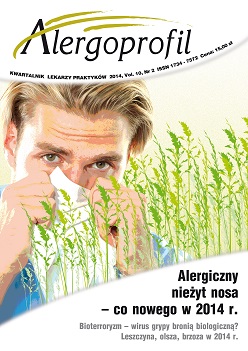Pollen of hazel, alder and birch in the air of Szczecin in the years 2012–2014
Main Article Content
Abstract
The course of hazel, alder, birch pollen seasons in Szczecin (Western Pomerania) in the years 2012–2014 is presented. Measurements were performed by the volumetric method (Lanzoni 2000 pollen sampler). Pollen season was defined as the period in which 98% of the annual total catch occurred. The linear trend for the beginning of the season over 15 years was also analysed. Pollen seasons began 2 weeks earlier for birch and 8 days earlier for alder; hazel pollen season, however, began 3 days later than expected. The threat of pollen allergens of taxa analysed in this study was the highest in 2014 over 3 years. Similarly, the number of days with daily concentration over the threshold value was, in each case, the largest in 2014. Seasonal Pollen Index of birch reached almost 23 000 and thus was the highest in the last 10 years.
Downloads
Article Details
Copyright: © Medical Education sp. z o.o. This is an Open Access article distributed under the terms of the Attribution-NonCommercial 4.0 International (CC BY-NC 4.0). License (https://creativecommons.org/licenses/by-nc/4.0/), allowing third parties to copy and redistribute the material in any medium or format and to remix, transform, and build upon the material, provided the original work is properly cited and states its license.
Address reprint requests to: Medical Education, Marcin Kuźma (marcin.kuzma@mededu.pl)
References
2. Comtois P.: Statistical analysis of aerobiological data. W: Methods in Aerobiology. Mandrioli P., Comtois P., Levizzani V. (red.). Pitagora Editrice Bologna, Bologna 1998, 217-259.
3. Corden J.M., Stach A., Millington W.M.: A comparison of Betula pollen seasons at two European sites; Derby, UK and Poznan, Poland (1995-1999). Aerobiologia 2002, 18: 45-53.
4. D’Amato G., Spieksma F.T.M.: Allergenic pollen in Europe. Grana 2004, 30: 60-70.
5. Gniazdowski R., Klimas F.: Wykorzystanie obserwacji palynologicznych i fenologicznych w ustalaniu szczegółowej etiologii pyłkowicy. Otolaryngol. Polska 1976, 30: 21-27.
6. Jäger S., Spieksma F.T.M., Nolard N.: Fluctuation and trends in airborne concentrations of some abundant pollen types, monitored at Vienna, Leiden and Brussels. Grana 1991, 30, 309-312.
7. Karakaya G., Kolyoncu A.F.: A case of anaphylaxis due to rose pollen ingestion. Allergol. Immunopathol. 2003, 31: 91-93.
8. Kowalski M.: Immunologia Kliniczna. Choroby Alergiczne. Mediton 2000, 137-241.
9. Lipiec A., Rapiejko P., Samoliński B., Krzych E.: Correlation between conjunctival provocation test results and conjunctival symptoms in pollinosis – preliminary report. Ann. Agric. Environ. Med. 2005, 12(1): 17-20.
10. Modrzyński M., Zawisza E.: Seasonal asymptomatic lower airway hyperresponsiveness in patients with allergic rhinitis. Med. Sci. Monit. 2000, 12(9).
11. Puc M., Kasprzyk I.: The patterns of Corylus and Alnus pollen seasons and pollination periods in two Polish cities located in different climatic regions. Aerobiologia 2013, 29: 495-511.
12. Rapiejko P., Lipiec A., Wojdas A., Jurkiewicz D.: Threshold pollen concentration necessary to evoke allergic symptoms. Int. Rev. Allergol. Clin. 2004, 10(3): 91-93.
13. Weryszko-Chmielewska E. (red.): Pyłek roślin w aeroplanktonie różnych regionów Polski. Wyd. Katedry i Zakł. Farmakognozji Wydz. Farmac. Akad. Medycznej im. Prof. F. Skubiszewskiego, Lublin 2006.
14. Weryszko-Chmielewska E., Piotrowska-Weryszko K.: Charakterystyka sezonów pyłkowych wybranych roślin alergennych w Lublinie w 2012 roku. Alergoprofil 2013, 1(9): 22-25.
15. Woś A.: Klimat Polski. PWN, Warszawa 1999.

